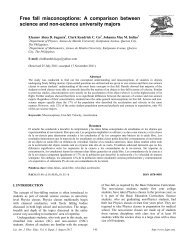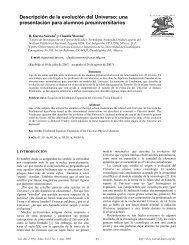Filament temperature of low power incandesecent lamps: Stefan ...
Filament temperature of low power incandesecent lamps: Stefan ...
Filament temperature of low power incandesecent lamps: Stefan ...
Create successful ePaper yourself
Turn your PDF publications into a flip-book with our unique Google optimized e-Paper software.
<strong>Filament</strong> <strong>temperature</strong> <strong>of</strong> <strong>low</strong> <strong>power</strong> <strong>incandesecent</strong><br />
<strong>lamps</strong>: <strong>Stefan</strong>-Boltzmann law<br />
Imtiaz Ahmad, Sidra Khalid and Ehsan E. Khawaja<br />
School <strong>of</strong> Science and Technology, University <strong>of</strong> Management and Technology,<br />
C-II Johar Town, Lahore 54770, Pakistan<br />
Phone: 092-42-5212801 EXT. 45, Fax 092-42-5184789<br />
E-mail: imtiaz.ahmad@umt.edu.pk<br />
(Received 28 October 2009; accepted 27 December 2009)<br />
Abstract<br />
An undergraduate experiment using commercially available <strong>low</strong> <strong>power</strong> incandescent <strong>lamps</strong> was performed. The results<br />
obtained, for higher <strong>temperature</strong> <strong>of</strong> the filament (say above 1000 K), were compared with those calculated using a<br />
simple model, based on transfer <strong>of</strong> electric <strong>power</strong> predominantly into Planck’s radiation channel through <strong>Stefan</strong>-<br />
Boltzmann law. The agreement between the results and the theory was quite satisfactory. Measurement <strong>of</strong> filament<br />
<strong>temperature</strong> to confirm theoretical results, included in the present work, is expected to give a student more confidence<br />
in the theory.<br />
Keywords: Laboratory experiment, radiative heat transfer, radiation detectors.<br />
Resumen<br />
El presente trabajo muestra el desarrollo de un experimento a nivel bachillerato utilizando lámparas incandescentes de<br />
baja potencia y disponibles de manera comercial. Los resultados obtenidos a altas temperaturas del filamento (cerca de<br />
los 1000K) fueron comparados con los calculados utilizando modelos simples, basándose principalmente en la<br />
transferencia de potencia eléctrica predominante en la radiación de canal de Plank a través de la ley de <strong>Stefan</strong>-<br />
Boltzmann. La correspondencia entre los resultados y la teoría fue bastante satisfactoria. Las mediciones de<br />
temperatura hechas al filamento confirman los resultados teóricos, los cuales se incluyen en el presente trabajo, se<br />
espera que el estudiante adquiera una mayor seguridad respecto a la teoría aprendida.<br />
Palabras clave: Experimento de laboratorio, transferencia de calor por radiación, detectores de radiación.<br />
PACS: 01.50.Pa, 44.40.+a, 0.7.57.Kp,29.40.-n,85.25.Pb ISSN 1870-9095<br />
I. INTRODUCTION<br />
There are a number <strong>of</strong> methods for estimating the<br />
<strong>temperature</strong> <strong>of</strong> the filament <strong>of</strong> incandescent <strong>lamps</strong> [1, 2, 3,<br />
4, 5]. These methods are for example (i) the <strong>power</strong> law<br />
between the resistance, R, and <strong>temperature</strong>, T, <strong>of</strong> tungsten<br />
filament, (ii) the transfer <strong>of</strong> the input electric <strong>power</strong><br />
predominantly into Planck’s radiative channel through<br />
<strong>Stefan</strong>’s law, (iii) exploits the fact that the lifetime <strong>of</strong> the<br />
lamp filament is mostly governed by the rate <strong>of</strong> thermal<br />
evaporation <strong>of</strong> the metal, (iv) analyses <strong>of</strong> the radiation<br />
emitted by the filament at two well defined wavelengths<br />
and (v) study <strong>of</strong> hysteresis in the current-voltage<br />
characteristics in filament lamp.<br />
Incandescent light bulbs, in addition to providing<br />
illumination, are useful in the context <strong>of</strong> teaching physics<br />
[2, 4]. In the present work two sets <strong>of</strong> measurement were<br />
made on commercially available <strong>low</strong> <strong>power</strong> <strong>lamps</strong>. These<br />
measurements were made on lamp filament: (a) resistance<br />
(R) – voltage (V) and (b) <strong>temperature</strong> (T) – voltage.<br />
An attempt is made to relate these results to those<br />
derived on the basis <strong>of</strong> transfer <strong>of</strong> the electrical <strong>power</strong><br />
predominantly into Planck’s radiation channel through<br />
<strong>Stefan</strong>-Boltzmann law.<br />
II. EXPERIMENTAL<br />
In the present work three 12-V operated <strong>low</strong> <strong>power</strong> (rated<br />
at 10-W, 25-W and 35-W) commercial <strong>lamps</strong> were<br />
studied. Current (I) – voltage measurements were<br />
performed using a variable dc <strong>power</strong> supply. Multimeters<br />
were used to measure the voltage across the filament and<br />
current in the series circuit. The resistance <strong>of</strong> the filament<br />
was obtained using R = V/I. The <strong>temperature</strong> <strong>of</strong> the<br />
filament at different voltage was measured using a<br />
Minolta-Land infrared optical pyrometer Cyclops 52. The<br />
<strong>temperature</strong>s were measured for different setting <strong>of</strong><br />
emissivity, such as 0.3, 0.35, and 0.4. The average value <strong>of</strong><br />
the emissivity for tungsten filament lamp is close to 0.35<br />
Lat. Am. J. Phys. Educ. Vol. 4, No. 1, Jan. 2010 74 http://www.journal.lapen.org.mx
<strong>Filament</strong> <strong>temperature</strong> <strong>of</strong> <strong>low</strong> <strong>power</strong> <strong>incandesecent</strong> <strong>lamps</strong>: <strong>Stefan</strong>-Boltzmann law<br />
[2]. Therefore, in this work e = 0.35 was used. However,<br />
the measured <strong>temperature</strong> values were larger (by less than<br />
2.5%) for e = 0.3 and smaller (by less than 1.5%) for e =<br />
0.4 when both compared with those obtained for e = 0.35.<br />
III. MODELING<br />
At a given voltage across the filament <strong>of</strong> the lamp, a steady<br />
state is reached when the current (I) passing through the<br />
filament is stabilized. In the steady state it is expected that<br />
the electrical <strong>power</strong> input to the lamp is equal to the <strong>power</strong><br />
lost by the filament through conductive, convective, and<br />
radiative processes, such that [2]<br />
V 2 / R = K (T – T0) + e σ As (T 4 – T0 4 ), (1)<br />
where K represents conductive and convective properties<br />
<strong>of</strong> the system. T and T0 are the <strong>temperature</strong>s in Kelvin for<br />
the filament and the ambient, respectively. e and As are the<br />
emissivity and surface area <strong>of</strong> the filament, respectively,<br />
and σ is the <strong>Stefan</strong>-Boltzmann constant.<br />
For higher <strong>temperature</strong> <strong>of</strong> the filament (say above 1000<br />
K), it is reasonable to assume that T 4 >> T0 4 . Moreover,<br />
for <strong>low</strong> <strong>power</strong> bulbs [2], such as those used in the present<br />
work, the literature indicates that convection and<br />
conduction losses are negligible. Hence Eq. (1) may be<br />
rewritten as<br />
V 2 = e σ As T 4 R . (2)<br />
Metal resistance increases with <strong>temperature</strong>. The<br />
<strong>temperature</strong> <strong>of</strong> tungsten in the range 300 K to 3655 K, can<br />
be given in terms <strong>of</strong> its resistivity (ρ) by the empirical<br />
relation, valid in SI units [7]<br />
T = 3.05 × 10 8 ρ 0.83 and<br />
p = 0.46. (6b)<br />
The resistance <strong>of</strong> the filament at room <strong>temperature</strong> (RRT) is<br />
given by<br />
RRT = ρRT (L / πr<br />
. (3)<br />
A <strong>power</strong> relation similar to this is also given in Ref. [3, 8].<br />
Eq. (3) may be written as<br />
2 ), (6c)<br />
where ρRT is the resistivity <strong>of</strong> tungsten at room<br />
<strong>temperature</strong>, given by Eq.(3).<br />
Similarly by eliminating R from Eq. (2) and (5), we<br />
obtain an expression relating T with V, such as<br />
T = B2 V q , (7)<br />
where<br />
B2 = 2.4 ×10 3 r 0.19 L –0.38 and<br />
, (7a)<br />
q = 0.38. (7b)<br />
In the present work we have measured R and T both as<br />
functions <strong>of</strong> V.<br />
IV. RESULTS AND DISCUSSION<br />
Three unbranded 12–V operated <strong>low</strong> <strong>power</strong> <strong>lamps</strong> were<br />
acquired from the local market. The cost <strong>of</strong> each <strong>of</strong> the<br />
three <strong>lamps</strong> is given in Table I. The values <strong>of</strong> the<br />
resistance (RRT) <strong>of</strong> the filaments <strong>of</strong> the three <strong>lamps</strong><br />
measured at room <strong>temperature</strong> are listed in Table I. These<br />
were measured using Wheatstone bridge method. The<br />
results <strong>of</strong> the measurement <strong>of</strong> R as a function <strong>of</strong> V for the<br />
<strong>lamps</strong> are shown in Figure 1.<br />
T = 3.05 × 10 8 [ (Ac R) / L ] 0.83 , (4)<br />
where Ac and L are the area <strong>of</strong> cross section and length,<br />
respectively, <strong>of</strong> the filament wire. Substituting this value<br />
<strong>of</strong> T in Eq. (2), we have<br />
V 2 = e σ As R {3.05 × 10 8 [ (Ac R) / L ] 0.83 }. (5)<br />
Also, As = 2πrL and Ac = πr 2 , where r is the radius <strong>of</strong> the<br />
filament wire. The value <strong>of</strong> e = 0.35 (fol<strong>low</strong>ing Clauss et<br />
al. [2]) and σ = 5.67 × 10 -8 Wm -2 K -4 were used in the<br />
present work. Thus, Eq. (5) becomes<br />
where,<br />
R = B1 V p , (6)<br />
B1 = 2.1 × 10 -7 L 0.54 r -1.8 , (6a)<br />
FIGURE 1. Resistance versus voltage curves obtained with 10<br />
W, 25 W and 35 W incandescent <strong>lamps</strong>.<br />
Lat. Am. J. Phys. Educ. Vol. 4, No. 1, Jan. 2010 75 http://www.journal.lapen.org.mx
Imtiaz Ahmad, Sidra Khalid and Ehsan E. Khawaja<br />
FIGURE 2. Log R curves (based on the data <strong>of</strong> Fig. 1). The dots<br />
represent experimental data and the straight line represents least<br />
square fit to the data generated by a computer.<br />
Using the data <strong>of</strong> figure 1, log R versus log V is plotted in<br />
Figure 2. The dots in Figure 2 represent experimental<br />
results while straight line is the result <strong>of</strong> computer<br />
generated least square fit to the data. The slope and yintercept<br />
<strong>of</strong> a straight line (Figure 2) give, respectively, the<br />
<strong>power</strong> p <strong>of</strong> V and log B1 (see Eq.6). The values <strong>of</strong> the<br />
exponent p and B1 thus obtained from Figure 2, are listed<br />
in Table I. These values <strong>of</strong> p are close (within 7%) to the<br />
theoretical value <strong>of</strong> p = 0.46 (Eq.6b). For the measured<br />
values <strong>of</strong> B1 and RRT (table I), and the value <strong>of</strong> ρRT<br />
Rated<br />
<strong>power</strong> <strong>of</strong><br />
lamp (W)<br />
Cost<br />
($)<br />
obtained from Eq. (3), Eqs. (6a) and (6c) could be solved<br />
simultaneously to obtain the values <strong>of</strong> L (length) and r<br />
(radius) <strong>of</strong> the filament wire. These parameters for the<br />
three <strong>lamps</strong> are listed in Table I.<br />
The results <strong>of</strong> the measurement <strong>of</strong> filament<br />
<strong>temperature</strong>, T, as a function <strong>of</strong> V for the three <strong>lamps</strong> are<br />
shown in Figure 3.<br />
FIGURE 3. Temperature versus voltage curves obtained with<br />
10W, 25 W and 35 W incandescent <strong>lamps</strong>.<br />
TABLE I. Various parameters <strong>of</strong> the lamp filaments: Study <strong>of</strong> R as a function <strong>of</strong> V.<br />
*R RT (Ω) **Measured B 1 (Ω-<br />
V -0.46 )<br />
**Exponent p ***Δp Length <strong>of</strong><br />
filament wire L<br />
(cm)<br />
Radius <strong>of</strong><br />
the filament<br />
wire r (μm)<br />
10 0.08 1.8 5.8 0.45 2% 9.5 32<br />
25 0.15 0.68 2.0 0.49 7% 17 69<br />
35 0.50 0.50 1.7 0.48 5% 12 68<br />
* R RT is the filament resistance at room <strong>temperature</strong>, measured by Wheatstone bridge method.<br />
** Determined from plot <strong>of</strong> log R versus log V (Figure 2).<br />
*** Δp = { [׀0.46 – p ׀] / 0.46 } × 100<br />
FIGURE 4. Log T versus log V curves (based on the data <strong>of</strong><br />
figure 3). The dots represent experimental data and the straight<br />
line represent least square fit to the data generated by a computer.<br />
Using the data <strong>of</strong> Figure 3, log T versus log V is plotted in<br />
Figure 4. The dots in Figure 4 represent experimental<br />
results while straight line is the result <strong>of</strong> computer<br />
generated least square fit to the data. The slope and yintercept<br />
<strong>of</strong> a straight line (Figure 4) give, respectively, the<br />
<strong>power</strong> q <strong>of</strong> V and log B2 (see Eq.7). The values <strong>of</strong> the<br />
exponent q and B2 thus obtained from Figure 4, are listed<br />
in Table II. These values <strong>of</strong> q are within 16% to the<br />
theoretical value <strong>of</strong> q = 0.38 (Eq. 7b). Using the values <strong>of</strong><br />
the parameters L and r (Table I), B2 were calculated from<br />
Eq. (7a). These are also listed in Table II. The difference<br />
between the calculated and measured values <strong>of</strong> B2 was<br />
found to be as large as 22% (see Table II).<br />
Simple model used in the present work was based on<br />
some assumptions which may introduce errors. The<br />
filament was assumed to be uniform cylinder <strong>of</strong> crosssectional<br />
area Ac and length L. The assumption <strong>of</strong><br />
Lat. Am. J. Phys. Educ. Vol. 4, No. 1, Jan. 2010 76 http://www.journal.lapen.org.mx
uniformity neglects the possibility that a real filament has<br />
thin regions due to mechanical processing needed to form<br />
the coil as well as evaporation during using which<br />
effectively limits the useful lifetime <strong>of</strong> the lamp [2]. The<br />
assumption <strong>of</strong> a cylinder instead <strong>of</strong> a coil will overestimate<br />
the effective radiating area [6], since the regions on the<br />
inside <strong>of</strong> a coil radiate back and forth, trapping some <strong>of</strong> the<br />
energy and resulting in higher filament <strong>temperature</strong>s than<br />
would be obtained with a straight cylinder. This is more<br />
obvious in the 25-W lamp since measured <strong>temperature</strong> (at<br />
given voltage) is larger than that calculated (Table II). On<br />
the contrary the measured <strong>temperature</strong>s were smaller than<br />
<strong>Filament</strong> <strong>temperature</strong> <strong>of</strong> <strong>low</strong> <strong>power</strong> <strong>incandesecent</strong> <strong>lamps</strong>: <strong>Stefan</strong>-Boltzmann law<br />
those calculated for 10–W and 35–W <strong>lamps</strong>. On<br />
examining lamp filaments under a magnifying glass it was<br />
observed that spacing between the turns was much smaller<br />
in case <strong>of</strong> 25–W lamp as compared with the corresponding<br />
for the 10–W or 35–W <strong>lamps</strong>. The volumetric thermal<br />
expansion <strong>of</strong> the filament only provides a correction <strong>of</strong><br />
less than 2 % [5]. Chemical impurities in the tungsten wire<br />
may be another factor that have contributions to the<br />
observed differences in the measured and calculated values<br />
<strong>of</strong> various parameters (Tables I and II).<br />
TABLE II. Various parameters <strong>of</strong> the lamp filaments: Study <strong>of</strong> T as a function <strong>of</strong> V.<br />
Rated <strong>power</strong><br />
<strong>of</strong> lamp (W)<br />
*Exponent q **Δq *Measured B2 (Ω-K-V -0.38 )<br />
***Calculated B2 (Ω-K-V -0.38 )<br />
****ΔB2 10 0.32 16% 8.7 × 10 2 8.2 × 10 2 6%<br />
25 0.35 8% 9.3 × 10 2 7.6 × 10 2 22%<br />
35 0.35 8% 9.1 × 10 2 8.7 × 10 2 5%<br />
* Determined from plot <strong>of</strong> log T versus log V (Figure 4).<br />
**Δq = {[׀0.38 – q ׀] / 0.38 } × 100.<br />
*** Calculated from Eq. (7a) using the values <strong>of</strong> L and r from Table I.<br />
**** ΔB2 = ׀[(Calculated B2 – Measured B2) / Calculated B2] ׀× 100.<br />
It was reported [5] that emissivity <strong>of</strong> the filament depends<br />
on its <strong>temperature</strong>. When emissivity <strong>of</strong> the filament is<br />
assumed to be independent <strong>of</strong> <strong>temperature</strong>, then we have<br />
electric <strong>power</strong> is proportional to T 4 , and this would give<br />
and<br />
R proportional to V p , where p = 0, (Eq. 6)<br />
T proportional to V q , where q = 0.38. (Eq. 7)<br />
If we take emissivity to be proportional to T (as in Ref. [5]),<br />
then we have electric <strong>power</strong> proportional to T 5 , and this<br />
would give<br />
and<br />
R proportional to V 0.39 ,<br />
T proportional to V 0.32 .<br />
The average value <strong>of</strong> the exponent, p, is 0.47 (Table I) and<br />
this is closer to 0.46 (for emissivity being independent <strong>of</strong> T)<br />
rather than 0.39 (the value for emissivity being dependent<br />
on T). Fol<strong>low</strong>ing above this value <strong>of</strong> p suggests that the<br />
emissivity may not depend significantly on <strong>temperature</strong>.<br />
The average value <strong>of</strong> exponent q = 0.34 (T versus V q , table<br />
II). This suggests that the emissivity may depend on<br />
<strong>temperature</strong>, though not necessarily a linear dependence.<br />
However, the results <strong>of</strong> R versus V are less affected as<br />
compared with the results <strong>of</strong> T versus V, by the<br />
uncertainties (outlined above) involved in this work.<br />
Therefore, we may suggest that emissivity <strong>of</strong> the filament is<br />
nearly independent <strong>of</strong> <strong>temperature</strong> in the present case. It<br />
was concluded in Ref. [5] that for tungsten filament whose<br />
surface is oxidized its emissivity is independent <strong>of</strong><br />
<strong>temperature</strong>. May be this is the case in the present work.<br />
V. CONCLUSIONS<br />
An experiment using <strong>low</strong>-<strong>power</strong> incandescent <strong>lamps</strong> for the<br />
verification <strong>of</strong> <strong>Stefan</strong>-Boltzmann law was carried out. Two<br />
separate sets <strong>of</strong> measurements were made on the <strong>lamps</strong>.<br />
These included filament resistance versus applied voltage<br />
and filament <strong>temperature</strong> versus applied voltage. The<br />
results were compared with those calculated using a simple<br />
model. Overall, satisfactory results were obtained.<br />
Such an experiment may be a good addition in student<br />
laboratory. Measurement <strong>of</strong> filament <strong>temperature</strong> to<br />
confirm theoretical results is expected to give a student<br />
some confidence in theory. Most <strong>of</strong> the equipment used is<br />
readily available in the laboratory or can be easily acquired<br />
from a local market. Some effort is needed to acquire a<br />
pyrometer for measuring the filament <strong>temperature</strong>.<br />
ACKNOWLEDGEMENT<br />
The support provided by the University <strong>of</strong> Management<br />
and Technology is acknowledged.<br />
REFERENCES<br />
[1] Agrawal, D. C. and Menon, V. J., Lifetime and<br />
<strong>temperature</strong> <strong>of</strong> incandescent <strong>lamps</strong>, Phys. Educ. 33, 55-58<br />
(1998).<br />
[2] Clauss, D. A., Ralich, R. M. and Ramsier, R. D.,<br />
Lat. Am. J. Phys. Educ. Vol. 4, No. 1, Jan. 2010 77 http://www.journal.lapen.org.mx
Imtiaz Ahmad, Sidra Khalid and Ehsan E. Khawaja<br />
Hysteresis in a light bulb: connecting electricity and<br />
thermodynamics with simple experiments and simulations,<br />
Eur. J. Phys. 22, 385-394 (2001).<br />
[3] Zanetti, V., Temperature <strong>of</strong> incandescent <strong>lamps</strong>, Am. J.<br />
Phys. 53, 546-548 (1985).<br />
[4] Edmonds, I. R., <strong>Stefan</strong>-Boltzmann law in laboratory,<br />
Am. J. Phys. 36, 845-846 (1968).<br />
[5] Prasad, B. S. N. and Mascarenhas, R. A., Laboratory<br />
experiment on the application <strong>of</strong> <strong>Stefan</strong>’s law to tungsten<br />
filament electric lamp, Am. J. Phys. 46, 420-423 (1978).<br />
[6] Leff, H. S., Illuminating physics with light bulbs, The<br />
Phys. Teacher 28, 30-35 (1990).<br />
[7] 36 th International Olympaid, Salamanca , Planck’s<br />
constant in the light <strong>of</strong> an incandescent lamp, webpage<br />
www.jyu.fi/tdk/kastdk/olympiads/2005/Exp.pdf Spain<br />
(2005).<br />
[8] Denardo, B., Temperature <strong>of</strong> a lightbulb filament, The<br />
Phys. Teacher 40, 101-105 (2002).<br />
Lat. Am. J. Phys. Educ. Vol. 4, No. 1, Jan. 2010 78 http://www.journal.lapen.org.mx


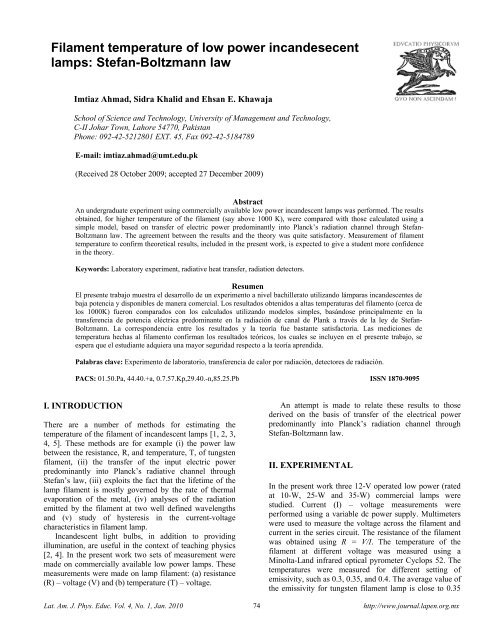
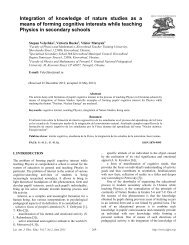
![Diversas formas de visualizar estados en un sistema cuántico [PDF]](https://img.yumpu.com/51151303/1/190x245/diversas-formas-de-visualizar-estados-en-un-sistema-cuantico-pdf.jpg?quality=85)

![Precession and nutation visualized [PDF]](https://img.yumpu.com/50786044/1/190x245/precession-and-nutation-visualized-pdf.jpg?quality=85)
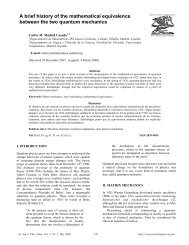
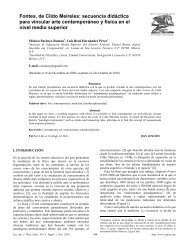
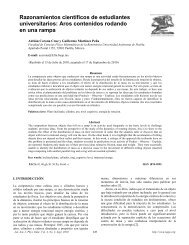

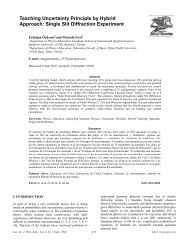
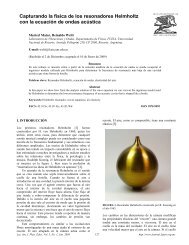
![Index [PDF] - Latin-American Journal of Physics Education](https://img.yumpu.com/47984121/1/190x245/index-pdf-latin-american-journal-of-physics-education.jpg?quality=85)
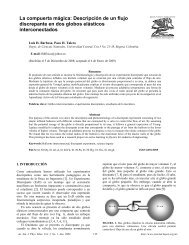
![Flujo de agua en botellas como experimento didáctico [PDF]](https://img.yumpu.com/43536300/1/190x245/flujo-de-agua-en-botellas-como-experimento-didactico-pdf.jpg?quality=85)
